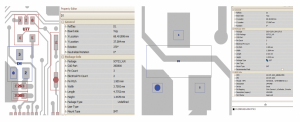Improving PCB Inspection Data Preparation Means Less Machine Downtime
By Mark Laing, Valor Division, Mentor, A Siemens Business
Let’s take a look at some simple but effective ways to reduce the programming time for PCB AOI and AXI inspection machines, which would translate into less machine downtime and faster time to market.
Traditionally, process engineers have created inspection programs on the factory-floor machines from centroid files or the pick-and-place machine output files using inspection templates provided with each machine. In today’s high-mix, lower volume PCB assembly, this approach no longer is efficient. Each new product introduction will have some number of new parts that do not have existing inspection templates. This requires the process engineer to spend many hours, even a day, of valuable operating machine time creating new inspection templates, machine time that is not spent testing boards, not making money.
For PCB assemblers to achieve optimal time to market, they need to be able to reduce the programming time for new products. They need solutions that can reduce the programming time for AOI and AXI inspection machines. In this article, we’ll take a look at some improved methods to deliver a richer content of data to both AOI and AXI machines. We will review specific inspections machines that can benefit from these approaches today.
Typical PCB design files reference the component footprint with a name as defined by the PCB layout engineer. This name is based on their convention, and it can vary from one design location to another. This variation makes it difficult to create consistent algorithms that can be applied from design to design because the reference names change depending on the design source.
Adding True Package Data to the PCB Layout

Typical bare-board footprint data (left), and footprint with true manufacturer-specific package information added (right).
Data preparation applications have been using PCB layout data for many years but unlocking the real power in these applications requires the true manufacturer-specific package data to be added to this data set. If we expand the PCB bare-board data set with true pin and package information, we then have a much better data set that can be leveraged for inspection programming.
If we apply this data to each component location on the board, we have a much richer data set that can be used for inspection programming purposes. Once we add the default package information with the true manufacturer-specific package data, we have a much more complete representation of the board as it will be assembled.
From an inspection perspective, we not only know the true outline of the package, but we also can see where the pin contact areas are with respect to the copper pads on the board.
This data be used to improve data formats capable of delivering this enriched data to the AOI machines, thus reducing the AOI data transfer and programming time. Two good examples of this are the Cyberoptics AOI SRFF format and the Viscom vVision XML format. Both of these formats have the ability to deliver a much richer data content to the machine programming software.
In the cases where inspection models have not been defined for new components, the data can be used to improve the time to match to other models that may already exist in the inspection library or be used to accelerate the creation of new models if no similar ones are available. This rich data set can significantly reduce the programming times from days to hours or from hours to minutes.
Improving AXI Data Transfer
This same rich data set can also be used to improve the AXI programming time. The Agilent Technologies’ 5DX AXI machine is now sold as the Vitrox AXI machine. The NDF format used by these machines supports separate footprint and package data definitions. Therefore, the bare-board footprint data can be delivered to the machine independently of the package data.
With both sets of data being available to the programming software, inspection templates can be created based on the consistent package data rather than the variations that exist in CAD footprint naming conventions. In this case, accurate PCB and package data is available, but instead of longer times managing algorithms against footprint names, the number of algorithms can be reduced with the repeatable data from the manufacturer specific packages.
The TRI AXI machine can also benefit from reduced programming times though in a different fashion. The inspection family and algorithms are tied to the part number of the component instead of the footprint of the bare board. Like manufacturer package names, the assembler’s part number is consistent across designs making it a more robust vehicle to reduce programming time. In the TRI case, the off-line programming time can be significantly reduced by assigning the family and inspection algorithm through the part number for easy reuse across PCB designs. Instead of spending significant amounts of time assigning this data on the machine, reusable assignment can be achieved up front in the data preparation software before the data set is delivered to the machine.
About the author:
Mark graduated with a B.Sc. in Electrical and Electronic Engineering from Loughborough University, in the UK. He has over 25 years’ experience in PCB manufacturing with particular strengths in test and inspection methodologies with three test companies, namely Marconi Instruments in the UK, followed by GenRad and Teradyne in the US. He then moved more in to software solutions for Router Solutions Incorporated, who were acquired by Mentor Graphics Corporation in 2006. When Mentor acquired Valor Computerized Systems in 2010 he moved in that division where he has been working as both a Product Marketing Manager and Business Development Manager. Mark has been granted two patents, one in the UK and one in the US, and has recently filed a third one. With the recent acquisition of Mentor by Siemens PLM, Mark is looking forward to further his career with Siemens. Mark has lived in the US for nearly 20 years and now resides in Lafayette, Colorado, with his wife and two sons.












